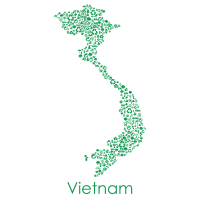1. Development
Economic reforms since the launch of the Renewal ( Đổi Mới ) in 1986, along with favorable global trends, helped propel Vietnam from one of the world's poorest nations to a middle-income economy in a single generation. Between 2002 and 2021, GDP per capita increased 3.6-fold, reaching nearly US$3,700. Poverty rates (US$3.65 per day, 2017 PPP) decreased from 14% in 2010 to 3.8% in 2020.
With its solid foundations, the economy has proven resilient in several crises. GDP growth is expected to slow to 6.3% in 2023, down from 8% in 2022, due to moderation in domestic demand and exports. Vietnam's economic growth is expected to rebound to 6.5% in 2024 as domestic inflation is likely to decline from 2024 onwards. This will be further supported by the accelerating recovery of its major export markets (the US, the eurozone and China).
Growing at 2.5% to 3.5% annually over the past three decades, the agricultural sector has supported economic growth and ensured food security. It contributed 14% of GDP and 38% of employment in 2020, earning over $48 billion in export revenue in 2021 during the peak of the COVID-19 pandemic.
Health outcomes have improved along with rising living standards. Infant mortality rates have declined from 32.6 per 1,000 live births in 1993 to 16.7 in 2020. Life expectancy has increased from 70.5 to 75.5 years between 1990 and 2020. Vietnam's universal health coverage index is at 73, higher than regional and global averages, with 87% of the population covered by the national health insurance scheme.
Vietnam's average length of schooling (adjusted for learning) is 10.2 years, second only to Singapore among the countries of the Association of Southeast Asian Nations. Its human capital index is 0.69 out of a possible one, the highest among lower-middle-income economies.
Access to infrastructure services has increased significantly. In 2019, 99.4% of the population used electricity as their primary source of lighting, up from just 14% in 1993. Access to clean water in rural areas has also improved, from 17% in 1993 to 51% in 2020.
Vietnam has become bolder in its development aspirations, aiming to become a high-income country by 2045. To achieve this, the economy should grow at an average annual rate of 5.9 percent per capita for the next 25 years. Vietnam also aims to grow greener and more inclusively, and has pledged to reduce methane emissions by 30 percent and halt deforestation by 2030, while achieving carbon neutrality by 2050.
Megatrends are shaping Vietnam’s future. The country’s population is rapidly aging and global trade is declining. Environmental degradation, climate change and rising automation are on the rise. The COVID-19 crisis has presented unprecedented challenges that could undermine progress towards development goals.
According to World Bank analysis, Vietnam can achieve its goals if it improves its performance, especially in the areas of finance, environment, digital transformation, poverty/social protection and infrastructure.
